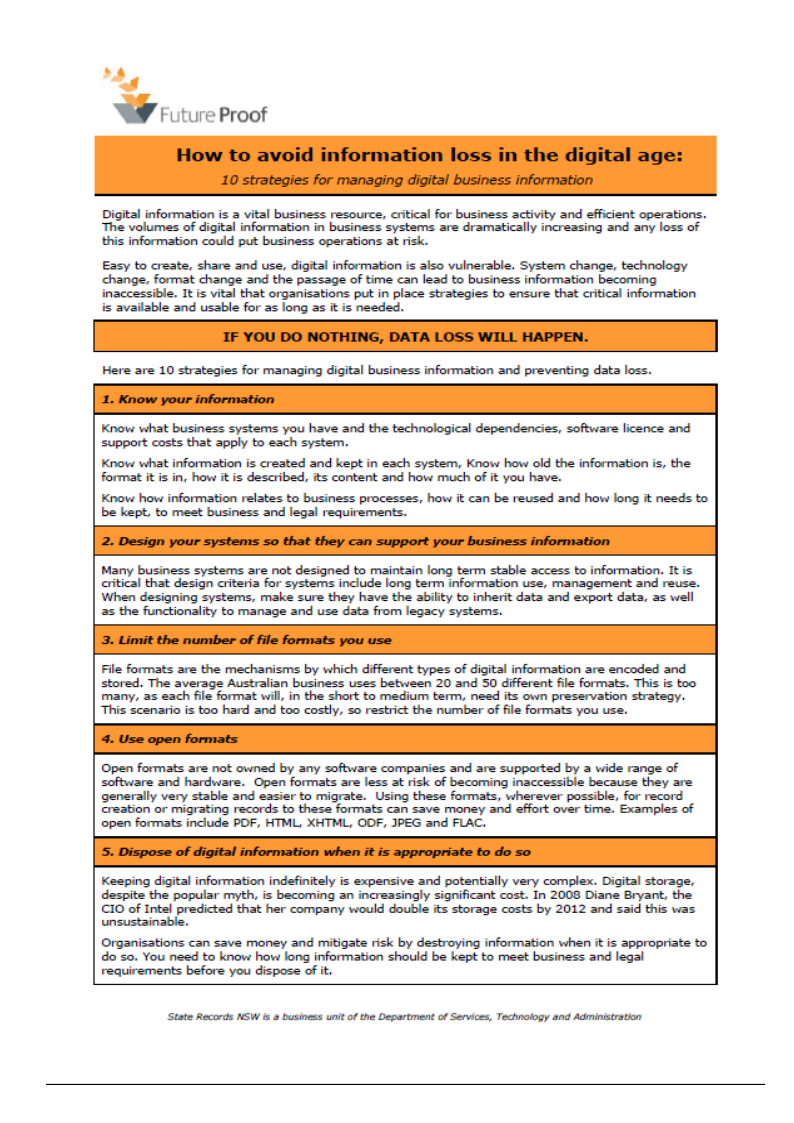How to avoid information loss in the digital age May 17, 2010
Digital information is easy to create, share and use and is today a vital business resource, critical for business activity and efficient operations.  Digital information however is very easy to lose and this can become a very costly problem for your organisation to manage and to deal with into the future.
Digital information however is very easy to lose and this can become a very costly problem for your organisation to manage and to deal with into the future.
It is easy to lose digital information because it can be:
- taken off line and lost in a sea of back up tapes and removable storage media
- trapped in a proprietary business system and be unavailable and unusable as a corporate resource
- given a bad title and lost in a plethora of digital information
- inaccessible in someone’s personal drive
- divorced from the metadata that helps to explain it and become just a collection of meaningless and unusable data
- unavailable as a business resource because its lack of connections to related emails, transactions, paper files and previous and subsequent versions mean that it cannot be relied upon or even understood
- migrated and lose its meaning and integrity in the process
- completely inaccessible due to its file format or other technical dependencies becoming outdated and unsupported
- supported by a proprietary and/or complex file format that becomes simply too costly and difficult to maintain
- literally lost in the vast collections of digital information spread throughout your organisation
- a liability and an expense to your organisation rather than an accountable and reusable asset.
Something has to be done. Do nothing, and your digital information will start to disappear and will become a very expensive problem for you to manage.
As our contribution to Information Awareness Month and to re-emphasise its messages about the importance of taking immediate action in order to maintain your digital information, we have developed a short summary of some key steps that organisations can take to help them to avoid information loss in the digital age.
The summary lists ten strategies that your organisation can employ to keep your critical business information available and accessible for as long as it is required. Used in conjunction with State Records’ other publications, the Standard on digital recordkeeping and Managing digital records, this plain-language how-to leaflet will be a useful starting point to help you and your organisation to avoid information loss now and in the future.
The leaflet is also a useful reminder that it is important to take steps NOW to preserve your digital information. Small steps taken now will make a significant difference to the future of your digital information.
Download How to avoid information loss in the digital age (PDF, 72kb)


“Reduce duplication” ???
And create a single point of failure. An ideal way to lose data.
It’s interesting because there is an emerging tension between the ‘single source of truth’ concept in recordkeeping and the idea that ‘lots of copies keeps stuff safe’ (eg the LOCKSS project) in digital preservation. I think perhaps the ‘reduce duplication’ argument should be made more specifically about paper / digital copies not digital / digital. Thanks for the input!
If an individual agency is keeping multiple copies of the same digital record, it is likely to be due to fundamental mismanagement rather than a deliberate strategy (the LOCKKS distributed copies principle IS part of its deliberate strategy). That being the case, this doesn’t engender faith in how the agency manages its information at a basic level – it’s a house of cards. Deduplication is a fact of life in emerging software which to my mind emphasizes the need to get the basics right from the outset.
[…] part of its contribution to Information Awareness Month the team at Future Proof have produced a leaflet outlining strategies to prevent data loss. Digital information is easy to create, share and use and […]
As most businesses are more concerned about documents and keeping them, I find it very ammusing that more companies are not using Google Docs. We have found it to be a fantastic solution to 99% of our document storage problem.